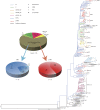The sexually driven epidemic in youths in China's southwestern border region was caused by dynamic emerging multiple recombinant HIV-1 strains
- PMID: 26133091
- PMCID: PMC4489098
- DOI: 10.1038/srep11323
The sexually driven epidemic in youths in China's southwestern border region was caused by dynamic emerging multiple recombinant HIV-1 strains
Abstract
Dehong prefecture, Yunnan province on China's southwestern border was the gateway of the country's AIDS epidemic. Studies on HIV-1 molecular epidemiology will provide key information on virus transmission dynamics and help to inform HIV prevention strategies. HIV-1 infected youths (age 16-25 years) diagnosed in the continuous 3 months in 2009 to 2012 were enrolled. By means of phylogenetic and statistical analyses, It was showed that two thirds (133/205) of youths in Dehong, of which 74.1% were infected sexually, were infected by uncharacterized recombinant HIV-1 strains. Among them about 59.4% (79/131) were unique recombinant forms (URFs) and 40.6% (54/131) formed 11 transmission clusters, termed potential circulating recombinant forms (pCRFs). The emergence of recombinants was statistically significant related with people of low education, residents outside the capital city of Dehong and being Myanmar residents. It was the first report with ongoing HIV-1 recombinant strains in a sexually driven epidemic area in China. Great efforts should be put on reducing multiple risk exposures behavior in local young people, containing the spread of pCRFs to other regions, and preventing the URFs from evolving into future CRFs. Collaborative prevention across border is needed to better control the local AIDS epidemic.
Figures


Similar articles
-
Phylodynamics of HIV-1 unique recombinant forms in China-Myanmar border: implication for HIV-1 transmission to Myanmar from Dehong, China.Infect Genet Evol. 2012 Dec;12(8):1944-8. doi: 10.1016/j.meegid.2012.08.001. Epub 2012 Aug 11. Infect Genet Evol. 2012. PMID: 22917657
-
On-going generation of multiple forms of HIV-1 intersubtype recombinants in the Yunnan Province of China.AIDS. 2002 Jul 5;16(10):1401-7. doi: 10.1097/00002030-200207050-00012. AIDS. 2002. PMID: 12131217
-
[HIV-1 gene subtypes among newly reported HIV/AIDS cases in two border areas of Yunnan province].Zhonghua Liu Xing Bing Xue Za Zhi. 2018 Dec 10;39(12):1617-1620. doi: 10.3760/cma.j.issn.0254-6450.2018.12.015. Zhonghua Liu Xing Bing Xue Za Zhi. 2018. PMID: 30572388 Chinese.
-
[Distribution of HIV-1 subtypes among different populations in Dehong prefecture, Yunnan province, in 2011].Zhonghua Liu Xing Bing Xue Za Zhi. 2012 Sep;33(9):883-7. Zhonghua Liu Xing Bing Xue Za Zhi. 2012. PMID: 23290795 Chinese.
-
Elucidation of Early Evolution of HIV-1 Group M in the Congo Basin Using Computational Methods.Genes (Basel). 2021 Apr 2;12(4):517. doi: 10.3390/genes12040517. Genes (Basel). 2021. PMID: 33918115 Free PMC article. Review.
Cited by
-
Geographic origin and evolutionary history of China's two predominant HIV-1 circulating recombinant forms, CRF07_BC and CRF08_BC.Sci Rep. 2016 Jan 14;6:19279. doi: 10.1038/srep19279. Sci Rep. 2016. PMID: 26763952 Free PMC article.
-
Prevalence and Clinical Impact of Human Pegivirus-1 Infection in HIV-1-Infected Individuals in Yunnan, China.Viruses. 2017 Feb 15;9(2):28. doi: 10.3390/v9020028. Viruses. 2017. PMID: 28212298 Free PMC article.
-
Using molecular network analysis to explore the characteristics of HIV-1 transmission in a China-Myanmar border area.PLoS One. 2022 May 6;17(5):e0268143. doi: 10.1371/journal.pone.0268143. eCollection 2022. PLoS One. 2022. PMID: 35522692 Free PMC article.
-
The origin and spread of CRF85_BC, driven by heterosexual transmission among older people in Sichuan, China.BMC Infect Dis. 2020 Oct 19;20(1):772. doi: 10.1186/s12879-020-05488-4. BMC Infect Dis. 2020. PMID: 33076868 Free PMC article.
-
Increase in HIV-1-transmitted drug resistance among ART-naïve youths at the China-Myanmar border during 2009 ~ 2017.BMC Infect Dis. 2021 Jan 21;21(1):93. doi: 10.1186/s12879-021-05794-5. BMC Infect Dis. 2021. PMID: 33478415 Free PMC article.
References
-
- Robertson D. L. et al. HIV-1 nomenclature proposal. Science 288, 55–56 (2000). - PubMed
-
- MA Y., Li Z. & Zhao S. HIV infected people were first identified in intravenous drug users in China. Chin J Epidemiol 11, 184–185 (1990).
-
- Shao Y. et al. Sequence analysis of HIV env genes among HIV infected drug injecting users in Dehong epidemic area of Yunnan province, China. Chin J Virol 10, 291–299 (1994).
Publication types
MeSH terms
LinkOut - more resources
Full Text Sources
Other Literature Sources
Medical
Molecular Biology Databases

